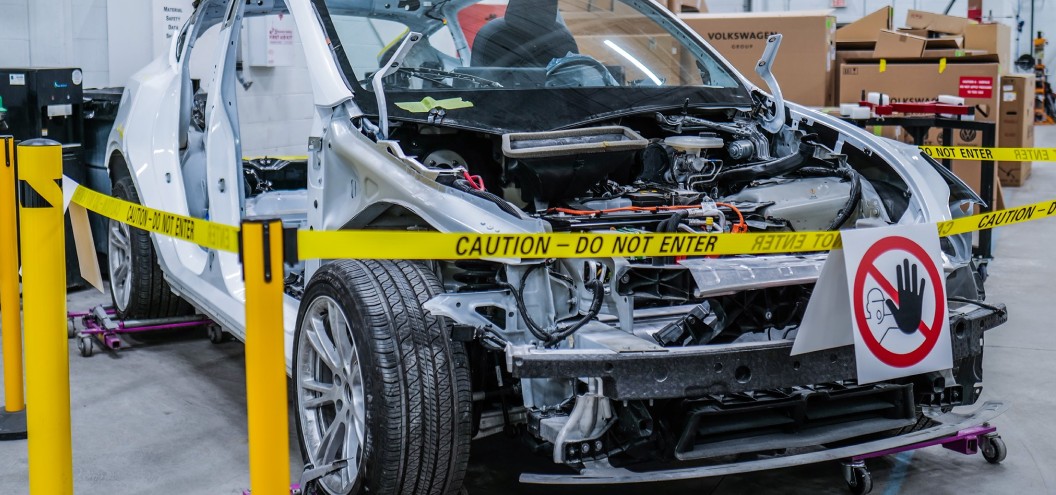Electric vehicles (EVs) are becoming increasingly common on our roads, lauded for their environmental benefits and advanced technology. As the popularity of EVs grows, so too does the likelihood of accidents involving these sophisticated machines. While EVs are built to be as safe as traditional gasoline cars in a collision, the repair process is significantly different and requires specialized knowledge and equipment. If you’re an EV owner and find yourself in a situation needing repairs, understanding the intricacies of electric car repair is crucial to ensure your vehicle is returned to its pre-accident condition, safely and correctly.
Understanding the Unique Challenges of Electric Car Repair
Repairing electric cars presents unique challenges compared to conventional vehicles, primarily due to their high-voltage systems and advanced construction materials. These factors necessitate specialized training, equipment, and procedures in collision repair facilities.
High-Voltage Systems: Safety First
Electric cars operate with high-voltage systems, often exceeding 400 volts, which are essential for powering the electric motor and battery. While these systems are designed to be safe during normal operation and even in accidents, they pose significant risks during repair if not handled correctly. Damaged high-voltage cables can be extremely dangerous, and technicians must be properly trained to identify, isolate, and safely work around these components. Bright orange markings typically identify high-voltage components, serving as a visual warning of potential hazards. Therefore, a standard auto body shop lacking EV-specific training and equipment may not be qualified to handle these repairs safely.
Advanced Materials and Construction
To maximize efficiency and range while counteracting the heavy weight of batteries, many EVs utilize advanced materials in their construction. Aluminum and carbon fiber are frequently used in EV chassis and body panels, offering strength and lightness. Tesla vehicles, for example, are well-known for their aluminum-intensive structures, while BMW’s i series incorporates a “carbon core” using carbon fiber reinforced plastic. These materials require specialized repair techniques and tools that differ significantly from those used on traditional steel car bodies. Attempting to repair these advanced materials with conventional methods can compromise the structural integrity of the vehicle and the safety of its occupants.
Key Steps in Electric Car Repair
The process of repairing electric cars involves several critical steps unique to these vehicles, ensuring both the safety of the technicians and the quality of the repair.
High-Voltage Battery Handling and Quarantine
One of the most critical aspects of electric car repair is the handling of the high-voltage battery. These batteries are not only heavy and bulky but also contain a significant amount of energy that can be dangerous if mishandled. In the event of a collision, the battery may need to be carefully removed and quarantined to prevent thermal runaway, which can lead to fires. Specialized procedures are required for battery removal, storage, and maintenance of its charge level. Maintaining the battery’s charge is crucial to ensure its proper function when reinstalled in the vehicle after repairs.
Specialized Equipment and Tools
Repairing electric cars necessitates a range of specialized equipment and tools that are not typically found in standard body shops. This includes:
- High-voltage safety equipment: Insulated gloves, tools, and personal protective equipment (PPE) are mandatory for technicians working on or around high-voltage systems.
- Battery lifting and handling equipment: Due to their weight and size, specialized lifts, scissor-lift platforms, or mobile battery tables are needed for safe battery removal and installation. Alignment dowels and borescopes might be necessary for precise connector alignment.
- Charging and battery maintenance equipment: To maintain the battery’s charge level during the repair process, specialized EV charging and maintenance equipment is required. In some cases, dedicated battery quarantine rooms with fire suppression systems may be necessary.
- Tools for advanced materials: Specific tools and equipment are needed for working with aluminum, carbon fiber, and other advanced materials used in EV construction, such as specialized welding equipment and bonding tools.
Recalibration of Safety Systems
Modern vehicles, especially EVs, are equipped with advanced driver-assistance systems (ADAS) and active safety features. These systems, such as lane departure warning, adaptive cruise control, and automatic emergency braking, rely on sensors, cameras, and radar. After a collision, even if the sensors or cameras appear undamaged, these systems often require recalibration to function correctly. This recalibration process is crucial for ensuring the safety features operate as intended by the manufacturer. Specialized tools, targets, and even dedicated calibration rooms with specific patterns are often required for accurate recalibration, as outlined by the vehicle manufacturer’s specifications.
Importance of Certified Technicians
Given the complexities of electric car repair, the expertise of technicians is paramount. Repairing EVs requires specialized training beyond traditional automotive repair. Technicians working on electric vehicles need to be certified and trained in high-voltage safety procedures, battery handling, advanced material repair, and ADAS calibration. Manufacturer-certified body shops ensure their technicians receive the necessary training and have access to the latest repair procedures and equipment.
Finding a Qualified Electric Car Repair Shop
Choosing the right repair facility is essential to ensure your electric car is repaired safely and correctly. Prioritizing facilities with the proper certifications and expertise will provide peace of mind and guarantee the quality of the repair.
Manufacturer Certifications
The most reliable way to ensure quality EV repair is to choose a repair facility certified by your vehicle’s manufacturer. Most EV manufacturers have established certification programs for body shops. These programs ensure that certified facilities have:
- Trained and certified technicians: Technicians have completed specific training programs on EV repair procedures and safety protocols.
- Specialized equipment and tools: The shop is equipped with the necessary tools and equipment for handling high-voltage systems, batteries, and advanced materials.
- Access to manufacturer repair procedures: Certified shops have access to the latest repair guidelines and technical documentation directly from the manufacturer.
- Quality standards: Certified facilities adhere to the manufacturer’s standards for repair quality and customer service.
Questions to Ask a Repair Shop
If you are unsure whether a repair shop is qualified to repair your electric car, here are some key questions to ask:
- “Are you certified by [my EV manufacturer] to repair electric vehicles?”
- “Do your technicians have specific training and certifications for EV repair and high-voltage systems?”
- “Do you have experience repairing electric vehicles, and specifically [my EV model]?”
- “What specialized equipment do you have for EV battery handling, high-voltage systems, and advanced materials?”
- “Do you follow manufacturer-approved repair procedures for electric vehicles?”
- “Can you recalibrate the safety systems and ADAS features on my EV after repair?”
Conclusion: Ensuring Safety and Quality in Electric Car Repair
Repairing electric cars is a complex process that demands specialized expertise, equipment, and adherence to safety protocols. While EVs are designed to be safe on the road and in collisions, their unique high-voltage systems and advanced materials require a different approach to repair compared to traditional gasoline vehicles. For EV owners, choosing a manufacturer-certified repair facility is the best way to ensure your vehicle is restored to its original safety and performance standards. By prioritizing certified shops, you are investing in quality workmanship, technician expertise, and ultimately, your safety and peace of mind on the road ahead.


